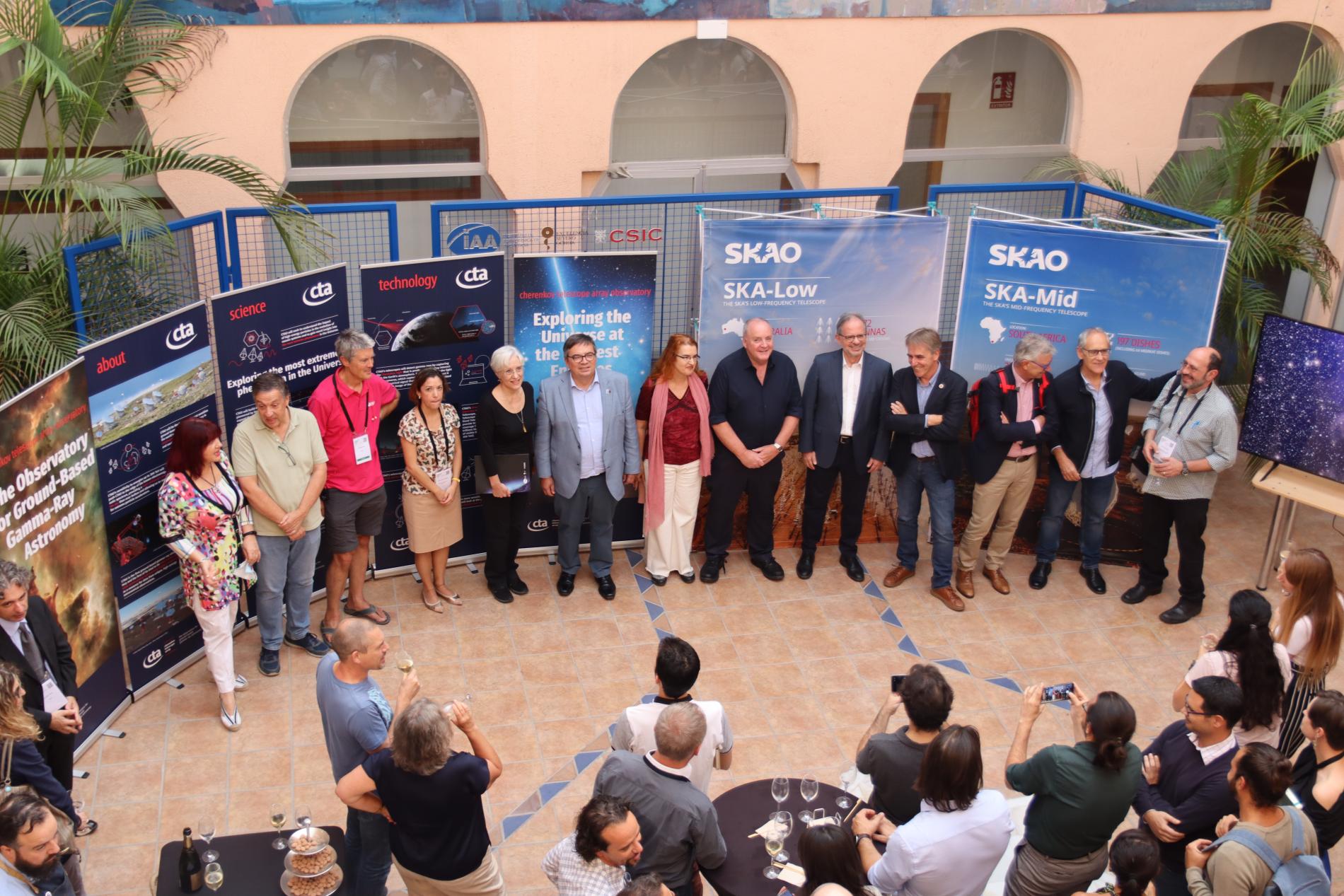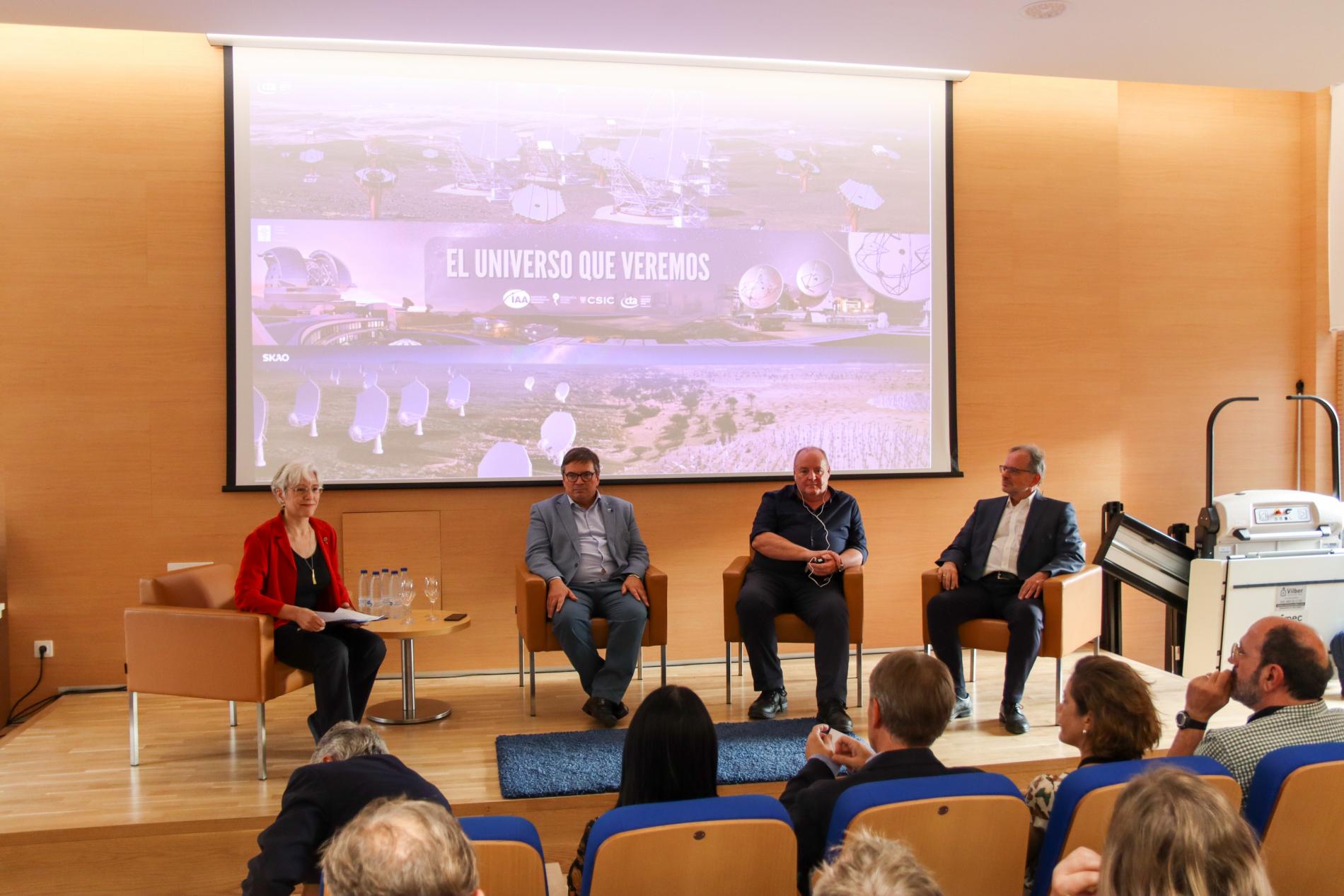The astronomy of the future will be collaborative, multi-wave, more diverse and green
The Institute of Astrophysics of Andalusia (IAA-CSIC) hosted yesterday a round table with the heads of three of the largest astronomical infrastructures on Earth: the Cherenkov Telescope Array Observatory (CTAO), the Extremely Large Telescope (ELT) and the Square Kilometre Array Observatory (SKAO). The nature of these facilities, which will open new windows on the cosmos in gamma-ray, optical and near-infrared and radio astronomy, involves major international collaboration and faces unprecedented technological challenges
Yesterday, in the auditorium of the Institute of Astrophysics of Andalusia (IAA-CSIC), a round table was held under the title "The Universe we will see", which discussed the present and future large ground-based astronomical infrastructures. Organised by the IAA-CSIC in collaboration with the Cherenkov Telescope Array Observatory (CTAO), and framed within the Big Science Business Forum (BSBF) conference being held this week in Granada, it was attended by Wolfang Wild, Project manager of the CTAO (Cherenkov Telescope Array Observatory) project, Xavier Barcons, general director of the European Southern Observatory (ESO), the institution behind the Extremely Large Telescope (ELT), and Philip Diamond, general director of the Square Kilometre Array Observatory (SKAO). The session, moderated by Isabel Márquez, director of the IAA-CSIC Severo Ochoa project, dealt with the current status of these three major astronomical projects, the novelties they will bring to the scientific community and their technological, energetic and social challenges.

The Cherenkov Telescope Array Observatory (CTAO) will be the leading astronomical observatory for very high-energy gamma rays for decades to come, and its scientific potential is extremely broad, ranging from understanding the role of relativistic cosmic particles to the search for dark matter. With more than sixty telescopes located in the northern and southern hemispheres (on the island of La Palma and in Chile), CTAO will be the first ground-based gamma-ray observatory and the world's most sensitive instrument for detecting high-energy radiation.
The ELT (ESO) project, which will operate from Chile, aims to observe the universe in the optical and infrared with even greater detail than the Hubble Space Telescope. Its 39-metre-diameter segmented mirror will allow the study of extrasolar planets and their atmospheres, planetary formation discs beyond our Solar System, dark energy and galaxy formation.
The SKAO, the largest scientific infrastructure planned to date, is an international effort to build the world's most powerful radio telescopes, consisting of a telescope with 197 dishes in South Africa and another with more than 130 000 low-frequency antennas in Australia. It will make it possible, among other things, to make a movie of the universe since the Big Bang, observe the first stars and galaxies, study ultra-compact objects such as pulsars, detect - if they exist - signs of extraterrestrial life and even detect the trail of collisions between black holes.
All three projects face huge, unprecedented technological challenges. Wild (CTAO) and Barcons (ESO) highlighted mechanical challenges, such as "moving a hundred-tonne telescope in twenty seconds" in the case of CTAO, or "getting 798 one-and-a-half-metre segments to work as a single mirror" in the case of the ELT. Diamond (SKAO) emphasised the scale of the project and the immense volume of data it will handle, as well as the difficulties associated with storing, processing and converting it into publishable science.
The three speakers highlighted the changes that this type of large astronomical infrastructure will bring about in scientific practice, which will lead to a prevalence of remote science. "The instruments are so complex and large that remote use will become the norm. It will be increasingly common to combine many wave ranges to obtain a complete picture of an object or process in the universe: multiwavelength astronomy is the future, and is what will allow us to fully understand these phenomena", says Wild (CTAO).

Another major challenge for such facilities is their location in remote regions of the planet, as well as the enormous amount of energy required to operate them. The need for these projects to be sustainable is clear: the use of photovoltaic power plants already powers part of the telescopes of the European Southern Observatory, and the SKAO antennas will be powered by solar energy in Australia and mostly in South Africa. Likewise, the construction of these infrastructures requires environmental care which, in the case of CTAO-North, has involved the development of prior environmental studies since its northern location, on the island of La Palma, is in a protected area.
The SKAO has also faced the challenge of building the antennas in areas traditionally owned by indigenous communities, who manage traditional land uses, and Philip Diamond (SKAO) has highlighted "the extreme care, respect and cooperative spirit that has driven the observatory and our partners locally", with education and socio-economic projects under development, and an Aboriginal land use agreement now being finalised between the Australian government and the Wajarri Yamaji community living where the SKAO low-frequency telescope will be located. ESO and CTAO have also stressed the importance of involving the local population and working with nearby companies, so that the inhabitants can take ownership of these large infrastructures and develop skilled jobs in regions where there were fewer opportunities before.
The three projects are an example of successful international collaborations, with many member states involved, and show a clear trend towards cooperative and diverse science. A science that will surely bring many surprises: the three speakers have agreed that, no matter how delimited the scientific objectives of each facility are, in a few decades we will see that questions that we had not even considered have been answered.
Instituto de Astrofísica de Andalucía (IAA-CSIC)
Unidad de Divulgación y Comunicación
Silbia López de Lacalle - sll[arroba]iaa.es - 958230676
https://www.iaa.csic.es
https://divulgacion.iaa.csic.es

